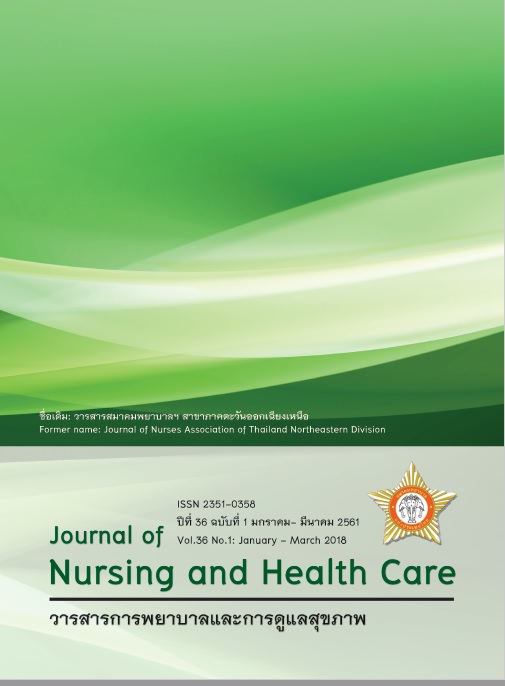การพัฒนาระบบการพยาบาลผู้ป่วยโรคหนังเน่าในโรงพยาบาลยโสธร Development of a necrotizing fasciitis nursing system in Yasothon Hospital
Abstract
This action research aimed to develop a necrotizing fasciitis nursing system and evaluate outcomes of the
system implementation in Yasothon Hospital during October 1, 2017 and January 31, 2018. Participants included
32 nurses working in the male and female surgical wards and a surgical ICU, 2 case managers, and 5 multidisciplinary
team members. The sample was 70 patients with necrotizing fasciitis (NF). The Kemmis & Mc Taggart’s participatory
action research model was adopted as the study framework to allow study participants to exchange experience,
reflect feelings, thoughts and beliefs and arrive at common understandings and awareness about NF-related problems
and eventually cooperate to develop a new nursing system for NF care. The study was conducted in 2 cycles with
4 phases in each cycle including 1) situational analysis through observations, in-depth interviews and focus group
discussion, 2) reflection and development of the new NF nursing care system, 3) NF nursing system implementation,
and 4) outcome evaluation and study conclusion. During the first cycle, the NF nursing practice guideline was
developed with the following components; NF admission protocol, a competency assessment form for new NF
patients, practice guideline for NF diagnosis and nursing care, and NF patient education manual. In the second
cycle, the infection assessment form was developed using the SOS score. Antibiotic dispensing system was revised
and the NF discharge planning system was developed. Wound dressing gauzes distribution system for Yasothon
Hospital’s networking health promoting hospitals was also established. Patient information referral system was
initiated to alert the health service agencies within the network before they admit NF patients in their care. Lastly,
the Wound Care Line group was established. Descriptive statistics were used to analyze quantitative data and paired
t-test was used to compare mean differences. A content analysis was used for qualitative information.
Development of the NF nursing system led to the following outcomes. 1) A holistic nursing process was
initiated with the use of SOS score to continually screen for new cases. This allowed NF patients a quick access to
treatment and care and the physicians and nurses cooperate to discharge plan. 2) Several innovations were
developed including the NF patient competency assessment, new NF case screening form using SOS score, a
practice guideline for NF diagnosis and nursing care, discharge planning documentation form and NF patient
referral form, NF patient health education manual, and a patient referral network through Wound Care Ling group.
3) All NF patients received proper antibiotics within 1 hour which led to infection risk reduction and reduced suffering
from wound pain. Most patients (88.9%) received discharge planning and did not experience readmission due to
lack of wound care materials in the health promoting hospitals or health personnel lack of wound care competencies.
Only 1 diabetes case (2.08%) was readmitted wit infected foot wound. All patients had significantly improved
NF-related knowledge (p<.01) and 60% of them reported a high level of satisfaction. 4) Nurses caring for NF patients
exchanged experience and cooperate to assist one another in assessing patients with infection, monitoring patient
conditions and vacuum dressing. As a result, most nurses reported the highest level of satisfactions with the new
NF nursing system (43.8%). infection, decrease suffering from pain, increase health education about disease
awareness , treatment plan and behave properly. The difference was statistically significant. (P-value < .01), LOS
8.29 , high mean scores nurse satisfaction



